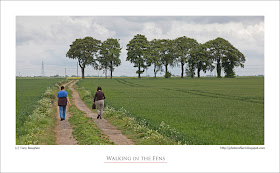click photo to enlarge
The Fenlands are one of those areas of England about which many people hold misconceptions: that is if they hold any conceptions at all! The first is that the Fens are to be found in Lincolnshire. They are, but they also extend into Cambridgeshire, Norfolk and a small area of Suffolk. Then there is the view that they are flat. That's essentially true, but the area has silt ridges, medieval sea banks, old salterns and small natural undulations that mean it isn't entirely flat. The Fens are a treeless landscape is a view that many hold. This certainly isn't true. There's no doubt that the Fens have fewer trees than most lowland areas, but there is no point where trees cannot be seen, most villages have plenty of them, small stands and individuals are common in open country, and the hedgerows feature quite a few too. There are even areas of new tree planting instigated by government grants.Most people know that the Fens produce prodigious quantities of vegetables and cereals, and often those who are aware of this assert that livestock is absent. In fact sheep, cows, and pigs are present in small but significant quantities - sheep in greater numbers in winter - and an assortment of pet/hobby livestock, from llamas to ponies are found in paddocks being tended by those engaged in "horseyculture". Wildlife enthusiasts consider the area bereft of animals and wild plants. As someone who has lived among the riches of the Yorshire Dales, by the Humber Estuary, and in the region of coast, plain and mountains that is north Lancashire, I can confirm that there are fewer of these than in some other areas, but that any walk in the Fens reveals a good range of birds, animals and plants for anyone who cares to look.The opinion also exists that walking in the Fens holds few attractions. For those of limited imagination and appreciation this may be true. However, for walkers of wider experience, who know that all landscapes offer interest to the discerning eye and mind, the charms of passing through this region on foot are many and unique. I had such a walk with my wife and a couple of friends the other day. On minor roads, farm tracks, footpaths and the banks of the South Forty Foot we meandered through crops and by waterways under an enormous sky, stopping to watch yellow wagtails, buzzards, reed buntings, sedge warblers and more. As we approached the stand of trees in the photograph we reflecetd on how they were allowed to remain standing, even after the old farmhouse that stood near them was taken down and a new one built nearby. Their presence showed that not all Fenland farmers try to squeeze every last drop of profit out of their land, and that some have a reverence for the landscape and a sense for those things that enhance its special beauty.
click photo to enlarge
Camera: Canon
Mode: Aperture Priority
Focal Length: 105mm
F No: f8
Shutter Speed: 1/200
ISO: 100
Exposure Compensation: -0.33 EV
Image Stabilisation: On
